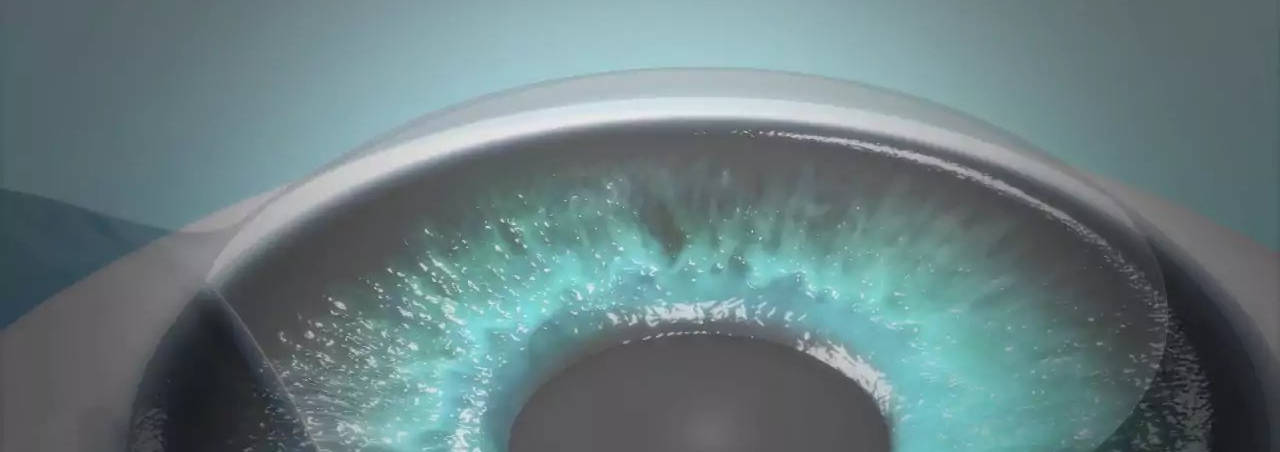

 by
Mamisoa Andriantafika
by
Mamisoa Andriantafika
Refractive surgery aims to compensate all refraction errors to be independant of any correction, glasses or contact lenses.
It usually does not aim to increase maximum corrected vision. Some situations exist where even with the optimal correction, the vision is not maximum at 20/20. A refractive surgery aims to achieve without glasses at least the vision you had with your previous correction.
Corneal surgery is the most common. Indeed, cornea is the most powerful refractive element of the eye. The surgeon will reshape the cornea to achieve the curvature required to compensate all refraction errors. Therfore, the importance of the refractive error will determine if corneal surgery is suitable.
Radial keratotomy, la PRK (photokératectomie réfractive) et le LASIK(LAser in-Situ Keratomileusis) are the most known refractive surgery.
Cornea is the most powerful refractive element of the eye.
Arciform incisions are still used to compensate astigmatism.
Radial keratotomy consisted to cut radial incisions deep in the cornea to induce a change in its curvature and get the required power. This technique This technique has been discontinued for many reasons, mainly: cornea gets instable and weak with time inducing an overcorrection, usually hyperopia, optical aberrations induced by incisions and inaccurate refractive results.
Nevertheless, there are still some indications to use arciform incisions to correct astigmatism by relaxing the cornea in a determined axis. It can be done manually or better with a femtosecond laser.
PRK and LASIK are the most common refractive surgery. A very meticulous preop exam is done beforehand. The cornea will be reshaped with an Excimer laser to compensate the refraction errors. It is done in the stroma which is a set of strong layers under the surface epithelium.
First step tp PRK is consisting in removal of the surface epithelium to expose the anterior stroma. The surgeon will use a mechanical scrapping to achieve the removal. Since few years, epithelial removal can be done with the Excimer laser which then permits to achieve an all laser refractive surgery. This surgery is called transepithelial-PRK.
The main advantage is that it requires very few manipulation. The main disavantage is postop pain which is present for about 2 days, and visual recovery that takes about seven days. We use this surgery for myopia under 4 diopters.
LASIK is performed first by dissecting a thin lamella of epithelium and anterior stroma which will be lifted to expose the underlying stroma. Excimer laser reshape the cornea and the lamellae is put back in place. The flap can be done mechanically or with a laser called a femtosecond laser. With the latter, the patient is then exposed to the femtosecond then the excimer laser. This surgery is called femto-LASIK. We use the latter as it is best to achieve a regular and accurate flap.
The Excimer laser used is the laser Wavelight EX500 from Alcon. The Femtosecond laser used is the Intralase IFS 150 from AMO. They both achieve a fast recovery in 2 to 3 days.
A more recent derived technique consists to dissect with the femtosecond laser a lamella of stromal tissue corresponding to the exact correction to eliminate. It is called SMILE (SMall LentIcuLE Extraction). Only the femtosecond laser is used, although the surgeon has to dissect and remove manually the lamella. This is a seducing technique. Nevertheless, ability to correct high refractive errors is smaller and redo are more difficult to achieve.
Femto-LASIK remains the reference technique.
Femto-LASIK is well indicated for myopia up to -9.50 dioptries and astigmatism up to -4.50 dioptries, depending of the initial state of the cornea. It is also possible to correct hyperopia up to +5.50 diopters.
Intracorneal inlays can be inserted in the cornea to achieve the required curvature. Use of intracorneal rings can correct highly irregular astigmatism found in situations like keratoconus. Some other inlays can simulate multifocality or increase the depth of focus to correct presbyopia. The main advantage here is its reversibility. To maximize the accuracy and minimize surgical manipulations, those surgery require the use of a femtosecond laser.
Intraocular surgery is usually the alternative when corneal surgery is not possible.
It consists in compensating refraction errors by inserting in the eye an additional intraocular lens or replace the natural lens by an artificial lens with adequate power. It is usually reserved for refraction errors too strong or if associated to presbyopia.
The phakic intraocular lens is an additionnal lens placed in front (e.g « Artisan », « Artiflex » or « Verisize » lenses) or behind (« ICL » or « IPCL » lenses) of the iris.
Replacement of the natural lens by an artificial intraocular lens is similar to cataract surgery. The bag containing the natural lens is open, this lens is broken in pieces and sucked with ultrasound sometimes assisted by femtosecond laser. Then a new lens is injected in the bag.
As the natural lens is removed, accommodation is impossible. It is compensated by intraocular multifocal lenses simulating pseudo-accommodation using a concept of simultaneous vision. There are numbers of lenses available. A preliminary discussion with your surgeon is required to do the best choice for the best results.
A preliminary discussion with your surgeon is required to do the best choice for the best results.
As all surgery, refractive surgery can involve some risks eventhough it is a comfort surgery.
Refractive surgery can involve complications.
Intrastromal surgery (PRK, LASIK et derived) can induce corneal inflammations. This inflammation is always present after surgery but controlled by a strict application of the planned treatment. Two follow-up are done during the first week and a month after. Sun glasses with category 3 UV protection are used during the month following and avoidance of exposition to sunlight is advised during the 6 following months.
PRK starts by removing the epithelium, un delayed epithelialisation can occur. The disappearance of pain after about 2 days postop is a good sign of surface's healing.
LASIK starts by creating a flap in the thickness of the cornea, a displacement can occur. It can be placed back or removed. It is important not to scrub the eyes during the first week following surgery. Shields are applied during the night to avoid unwilling scrubs. Risk of retinal detachment, even if really low, is possible. Careful inspection of the eye fundus checks for preliminary weak zones of the retina, and sometimes a preventive laser treatment on the retina is done before the refractive surgery. Ocular pression is also high while performing the flap. The use of a femtosecond laser is reducing the pressure applied on the eye performing the flap.
LASIK or PRK induce a temporary ablation of sensitive superficial nerves and then a loss of corneal sensistivity. This causes a lower tearing reflex leading to ocular dryness. Sensitivity is recovered usually between 6 to 12 months postop. It is important to lubricate the eyes with artificial tears without preservative prescribed by your surgeon for this time.
Corneal infection can occur, but the preventive treatment and the follow-up after surgery drastically lower this risk.
Dryness is the most common late complication.
Halos are usually limited and temporary.
Finally, the treatment zone can sometimes be smaller the the pupillary diameter at nigh causing some halos. The pupillary diameter is measured during the preop exam in night conditions, but some variations can still cause those halos. A medical treatment can be used or sometimes a redo to decrease those symptoms if they do not disappear with time.
Intraocular surgery can cause inflammation or infection. Treatment is related to its importance. A red and painful eye after a surgery should always lead to consult its surgeon in emergency.
This list of complications is not exhaustive. They are rare, sometimes not measurable. Good understanding of the surgery and implications, discussion with your surgeon and strict follow-up are the keys to a successful surgery.
Different refractive surgery are available: intra-stromal (te-PRK, LASIK, intrastromal implants) and intra-ocular (lenses, phaco-emulsification et implantation).
Your surgeon will choose the best fitted surgery for your situation. Most complications are easily controlled. As it is a comfort surgery on an healthy eye, it remains important to have a good understanding of the technique used, side effects and complications that can occur.
Your surgeon will choose the best fitted surgery for your situation.
Your surgeon will answer all your questions before surgery.
Those explainations do not remplace them in any ways.